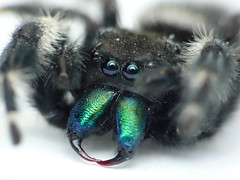Phidippus audax, my favorite species of Spider. I really love them, in a weird Steve Irwin kind of way.
Phidippus audax are a common jumping spider of North America. They are commonly referred to as the Bold Jumping Spider. The average size of adults ranges from roughly 3/8 to 3/4 inches in body length, though I have found several in Texas around the 1" mark. Yes, body length of 1". It's true, everything is bigger in Texas.
These spiders are typically black with a pattern of spots and stripes on their abdomen and legs. Often these spots are orange, yellow or red tinted in juveniles, turning white as the spider matures. I think they look like a smiley face.
The Bold Jumping Spider belongs to the genus Phidippus, a group of jumping spiders easily identified both by their relatively large size and their iridescent chelicerae. In the case of P. audax, these chelicerae are a bright, metallic green or blue. From the pic above, you know what chelicerae are now.
These spiders have been known to jump up to 50 times their own body length, and the male may jump away during mating if the female approaches too quickly.
Like other jumping spiders, due to their large, forward facing eyes, they have very good stereoscopic vision. This aides them when stalking prey, and allows some visual communication with others of their species, such as courting 'dances'.
While this guy may look very menacing, he's really only about 3/8 inch long. A curious little bugger too.
Raynox DCR-250
 mounted on my Panasonic Lumix FZ8.
mounted on my Panasonic Lumix FZ8.
Phidippus audax are a common jumping spider of North America. They are commonly referred to as the Bold Jumping Spider. The average size of adults ranges from roughly 3/8 to 3/4 inches in body length, though I have found several in Texas around the 1" mark. Yes, body length of 1". It's true, everything is bigger in Texas.
These spiders are typically black with a pattern of spots and stripes on their abdomen and legs. Often these spots are orange, yellow or red tinted in juveniles, turning white as the spider matures. I think they look like a smiley face.
The Bold Jumping Spider belongs to the genus Phidippus, a group of jumping spiders easily identified both by their relatively large size and their iridescent chelicerae. In the case of P. audax, these chelicerae are a bright, metallic green or blue. From the pic above, you know what chelicerae are now.
These spiders have been known to jump up to 50 times their own body length, and the male may jump away during mating if the female approaches too quickly.
Like other jumping spiders, due to their large, forward facing eyes, they have very good stereoscopic vision. This aides them when stalking prey, and allows some visual communication with others of their species, such as courting 'dances'.
While this guy may look very menacing, he's really only about 3/8 inch long. A curious little bugger too.
Raynox DCR-250

